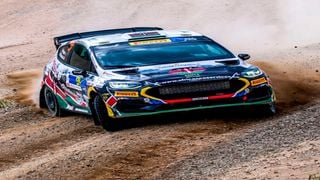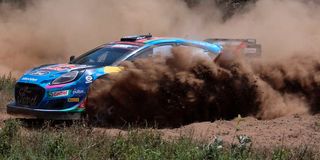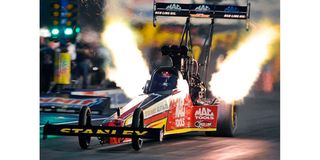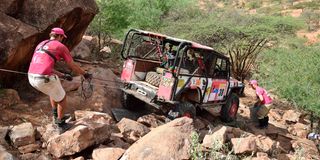
Hamza Anwar co-driven by Kenyan-American Joseph Kahurani in a Ford Fiesta R1 during the WRC Estonia.
| PoolDN2
Premium
Which motorsport needs the most special skills?
What you need to know:
- WRC Rallying has less absolute power and pace, but is still fast enough to make an unaccustomed passenger scream in terror.
- Drag racing has a track that could not be simpler. It is perfectly smooth, absolutely straight, and less than a kilometre long.
What form of competitive driving requires the most skill to win: Formula One, WRC Rallying, Desert Raids, Drag Racing, Le Mans… or the Rhino Charge?- HKM.
To be among the very best at any of them requires enormous skill, in many areas and different ways. And a whole lot more than just skill.
Yes, all involve driving a “car”. Anyone with enough aptitude, tuition and practice to do that competently can learn to drive the specialised vehicles in the sports you list. With most of these cars, an ordinary motorist can get in and go…sort of… and follow a prescribed route.
The exceptions are the two fastest – F1 and Drag – where the vehicles are so specialised and designed to operate at such high speeds that you and I would initially struggle to make them go at all, and if we managed that we would likely stall or crash them before we left the car park.
If and when we did get them up to some speed, there would be more surprises. For example, a car that depends on downforce for grip, and on pace for downforce, can do odd things like taking a corner at 100 kph (slow enough) or 200 kph (fast enough) as if it is on rails, but at 150 kph it could spin off!
And there is a very, very long way – in time, effort and learning – between getting them safely around a circuit just once, non-stop, and doing so with enough competitive competence that a talent scout might come and introduce himself to you.
And there is an even longer way than that between being reasonably competitive and being a world-class winner. Most of us have no chance of completing that journey in any of these sports, and experts would (very soon) be able to save us the time and trouble (and expense) of trying. We simply do not have what it takes.
Those who win a single event, never mind a championship or become “greats”, are – in several essential respects – freaks. They start with aptitudes – balance, co-ordination, visual acuity, reflexes, mental agility, spatial and looming judgment, and physical and psychological make-ups - at levels that cannot be wholly taught or learned.
To these attributes – perhaps summed up as special in-born talents – they must add herculean effort, determination, and single-minded ambition close to being obsessive to improve and refine those talents to become world-class elite.

Participants of the Rhino Charge competition entering the Kituruni checkpoint in Marsabit county on May 3, 2017.
One measure of how extreme all those factors must be is Q3 in an F1 Grand Prix. All 20 drivers try to set the fastest time round a single lap of circa 5 kms (more than a dozen corners including chicanes and hairpins, at speeds ranging from 80 to 300 kph, in about 90 seconds. If all were driving identical cars, the difference between first and last would be one second.
How nearly perfect, in every respect, must every one of their actions be? With unbelievable consistency. In a full race, for nearly two hours. And yet, even those tiny margins (results have to be timed to one-thousandth of a second) are not a matter of chance. As results show us, the best of the best in the battle are consistently better than the rest of the best by that fraction of a fraction of a second.
It is the speeds (and G-forces) involved – and that extraordinary degree of precision - that gives F1 a claim to being the most demanding “skill”, even though the road surface is near perfect, on a fixed circuit that drivers know with absolute predictability much better than they know the backs of their own hands.
In counterpoint there can be rain, mechanical strategy management, racing traffic, baulking manoeuvres, and constant changes in grip because of tyre wear and the weight change of fuel consumption. The sport’s ethos is optimisation of the potentials of Man and Machine.
WRC Rallying has less absolute power and pace, but is still fast enough to make an unaccustomed passenger scream in terror and it is done on a wide variety of road surfaces (tarmac, mud, sand, gravel, water splashes and sometimes deep snow and ice) with potholes and rocks, and bumps and ditches big enough to hurl the car a metre into the air and/or sideways into a forest. Day and night. Though an event might go on for several days, the concentration levels are so high that modern special stage rallying is driven in short bursts (called stages) that seldom last for more than a few minutes each.

Ott Tanak and his navigator Martin Jarveoja driving a Ford M-Sport compete at the Hell's Gate stage of the 2023 WRC Safari Rally on June 25, 2023.
Peak G-forces of acceleration, braking and cornering do not match F1, but they are accompanied by up-and-down bouncing of a completely different order. Absolute perfection is not essential. The extra special talents are reading and judging the road, and hair-trigger reaction and solution to the unpredictable.
In this respect and many others, Desert Raids are similar to Rallying, but not just on variable road surfaces. Often there is no road, or a desert piste that is two kilometres wide, over soft sand and where unpredictable hazards are usually felt before they are seen. Their stages can last non-stop for several hours, and the biggest events go on for several weeks! Their challenge is rallying, pacing…plus stamina and durability.
Drag racing has a track that could not be simpler. It is perfectly smooth, absolutely straight, and less than a kilometre long. But the vehicles are mostly two back wheels and an engine…with as much as 7,000 horsepower!

A drag racing car.
Their acceleration is so great that it generates the G-forces of a fighter jet; when their back wheels spin the centrifugal force can treble the height of their tyre sidewalls, and they rocket from a standstill to more than 400 kph in the length of three football fields…in under 4 seconds.
In that one run the “Top Fuel” category consumes 60 litres (more than 100 litres per kilometre!). They need a drogue parachute to help them stop. Their skill set is more learnable, and while the best no doubt have plenty of natural talent, too, in at least a few crucial respects even the also-rans aren’t Mr Average.
The Drag task tests fewer dimensions. What drivers have to be world-class good at is keeping the vehicle straight while riding a one-ton bullet fired from a cannon.
Le Mans? Somewhere between F1 and Rally car for speed, on a smooth and long racing circuit…for 24 hours, day and night. In the Man and Machine mix, one needs stamina and a strong bladder and the other needs durability in spades.
Methinks you have cited Rhino Charge only as one example “event” of a broad and diverse category of extremely tough and rough “no road” competitions which have dozens of different manifestations. Some of them are “races” up and down the sides of mountains, cliffs, rivers, swamps, and boulders the size of houses…sometimes requiring enough tyre tread, engine power and speed to drive flat-out across the surface a small lake without sinking.
Many of the essential skills can be learned, and a key requirement is extremely strong sphincter muscles. But again, if you examined drivers on the winner’s podium you would find some freaky in-born talents, too.
An almost unique feature of the Rhino Charge is that it is not, intrinsically, a race. The average speed over 10 non-stop hours is not much more than a walking pace. And it is not exclusively about Man and Machine “driving”.
It is about Men and Machine, about marathon running, about navigating, about reading a map and a landscape, about making strategic decisions and changes every minute, about judgment and tactics, about sunstroke and dehydration and cuts and bruises (and sometimes their more painful cousins).

Sean Avery's team Bundu Fundi tumbles down the Rhino Charge course at Nannapa Conservancy, Isiolo County on June 1, 2019.
It’s about winching and hefting boulders, it’s about a ride in the back that feels like being rolled down a rocky hillside in a metal barrel. You don’t need a natural talent for that, though it helps if you are a few bananas short of a bunch. It does require a high degree of driving skill, but more importantly the judgment to pick the right route “within” the ability of you and your car. Time management is crucial to success.
And once again, the winners are consistently those who are very, very good at what they are doing. Neither the incompetent, nor a novice, would stand a chance (first time). So wannabes, keep trying. Again and again. The challenges are never quite the same, and next time might require exactly the same skills you have and reward the mistakes you have previously made.





